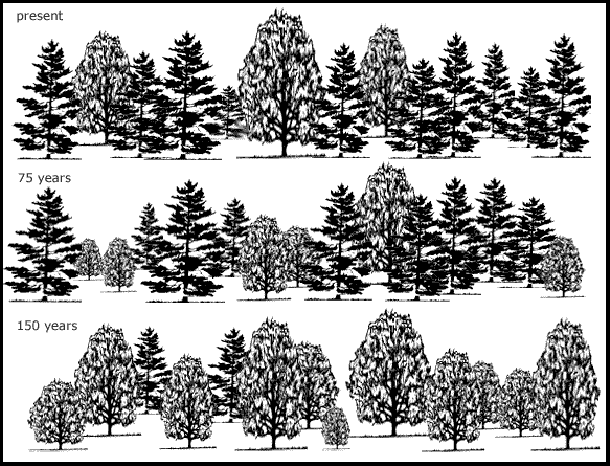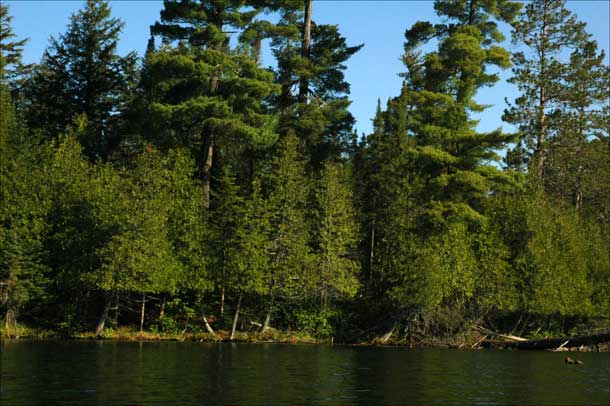Home > Sylvania > Growing concerns >
One of our growing concerns is
that Sylvania’s untouched natural environment, its old-growth forest and the creatures living in it, may change due to an overabundance of a native species, the white-tailed deer (Waller and Alverson 1997, Waller et al. 2009).
Deer browsing
The increase in deer density in the Great Lakes region from the very low levels of the 19th century to levels several times that of pre-European settlement is having an obvious effect on trees. In winter, deer may reach up to 6 feet (1.8 m) from the ground, creating the conspicuous browse line that is now very noticeable in many parts of Sylvania.
The effect of deer browsing on tree seedlings and on herbaceous understory plants is less easily determined because stunted growth, decreased abundance, or disappearance of species could be due to other factors, such as climate fluctuations or snowshoe hare densities. The potential impact can, however, be severe since browsing affects some species more than others, which could lead to a significant change on forest composition—a reduction in its richness—over time. For example, deer love eastern hemlock seedlings and plants with conspicuous flowers or fruits; slow growing species are affected more severely than fast growing ones; and rare species may be browsed to extinction.
Comparisons of species composition and abundance between areas with different deer densities (mainly due to hunting regulations) as well as enclosure studies have documented the impact. In the Great Lakes region, deer browsing has, for instance, been found to suppress the regeneration of certain tree species, such as hemlock and northern white cedar, and shrubs, such as Canada yew, and reduce the abundance of broad-leaf wildflowers, such as the slow-growing blue-bead lily (Clintonia borealis). At the extreme, deer can create park-like environments consisting of trees and a blanket of ferns which look clean and pretty but in which the trees will not regenerate.
Deer can also have an indirect, or cascading, effect by feeding on plants required by other species. A study of vegetation in the eastern U.S., for instance, found that the endangered Karner Blue Butterfly population was reduced by deer browsing on its lupine host plant. Bird census data revealed losses of some species, particularly those nesting in shrubs and at intermediate tree heights. Another example is the acorn which is food for both deer and the white-footed mouse. An overabundance of deer may negatively affect mice which in turn would affect the mice’s predators and prey (such as the gypsy moth).
The ecological impacts of overabundant deer populations are not easily assessed. They may take a long time to manifest themselves, and they are likely to go far beyond their direct effect on vegetation.
[D.M. Waller contributed to this article]
Browse line on Crooked Lake
Photo by W. Brinkmann
An illustration
Frelich and Lorimer (1985) modeled the long-term effects of deer browsing in a mixed conifer-hardwood forest in the UP. The present forest consists of mainly hemlock, with a few large surgar maples. Change does not occur quickly because there are a number of medium-sized hemlock trees that can take over the canopy as the oldest hemlock and maple trees die. After about 100 years, however, the forest composition changes rapidly and hemlock largely disappears.

Illustration by Wally B.

